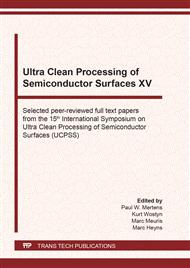p.3
p.9
p.17
p.23
p.29
p.34
p.41
p.49
Investigation of Contaminants in Single Wafer Wet Cleaning Using Isopropyl Alcohol
Abstract:
Technological control over ultra-trace level contaminants is important for semiconductor development. Despite technological developments, defects remain in the single wafer wet cleaning process. In this paper, the source of the contamination is explained via trace analytical methods. Fluorine resin materials of polytetrafluoroethylene (PTFE) and ethylene tetrafluoroethylene (ETFE) are commonly used in semiconductor equipment. Isopropyl alcohol (IPA) oxidation reactions occur at high temperature below the boiling point due to impurities. IPA changed to different alcohol forms from gas chromatography (GCMS) analysis. The oxygen concentration in the X-ray photoelectron spectroscopy (XPS) results increased and formed new bonds in IPA with fluorine resin. These reactions confirmed that cations were a catalyst from the time-of-flight secondary ion mass spectrometry (TOF-SIMS) results. Representative ions were Fe+, K+, and Na+ with different concentrations for each material.
Info:
Periodical:
Pages:
23-28
Citation:
Online since:
February 2021
Authors:
Keywords:
Price:
Сopyright:
© 2021 Trans Tech Publications Ltd. All Rights Reserved
Share:
Citation:


